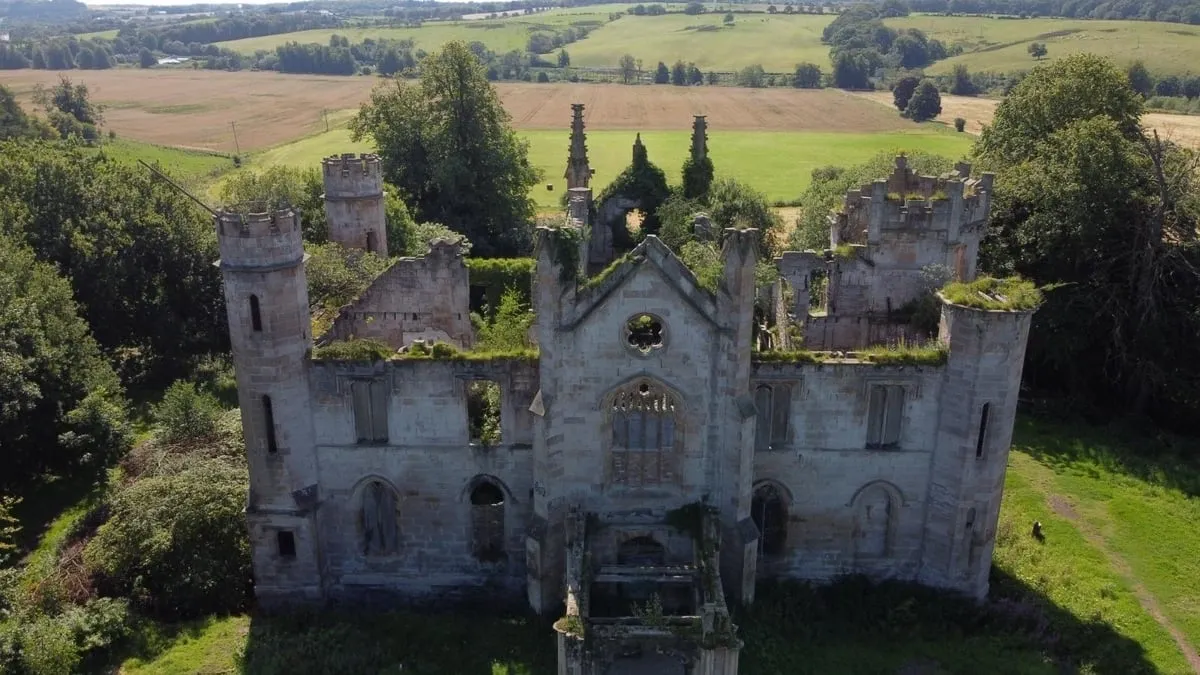Cambusnethan Priory, with its evocative Neo-Gothic architecture, holds a significant place in Scotland’s architectural heritage. Despite its current state of ruin, the remnants of this once grand mansion still captivate visitors with their historical charm.
Originally conceived as a residence for the Lockhart family, rather than a religious institution as its name might suggest, Cambusnethan Priory was designed by the renowned architect James Gillespie Graham and completed in 1820. Its construction marked a new chapter in the site’s long history, replacing earlier structures including a Norman tower house and a manor house destroyed by fire in 1816.

The mansion itself was a marvel of architectural sophistication, boasting turrets, chimneys, cornices, and castellated rooflines typical of the Neo-Gothic style. Octagonal corner towers and a central entrance with ornate gates added to its imposing presence, while a mix of pointed arched and rectangular windows flooded its interior with natural light. The Lockhart family’s coat of arms, proudly displayed at the main entrance and on the balustrades of the grand staircase, served as a symbol of their status and heritage.
Surrounding the mansion were magnificent gardens, although sadly, they no longer exist today, leaving behind only traces of their former splendor. While much about this period remains shrouded in mystery, the architectural legacy of Cambusnethan Priory continues to intrigue and inspire visitors, offering a glimpse into Scotland’s rich cultural past.

The 1960s marked a significant turning point for Cambusnethan Priory, as it transitioned from office space to a potential hospitality venue under the ownership of Ronald Wilson. Facing the looming threat of demolition in 1967, Wilson stepped in and acquired the property, envisioning its transformation into a restaurant and hotel.
During the 1970s, the mansion gained popularity for its banquet hall, which hosted mock medieval-style banquets. To create an authentic atmosphere, the banquet hall underwent renovations, revealing its bare stone walls.
By February 1980, extensive renovations had been completed, allowing Cambusnethan Priory to operate as a hotel. Despite efforts to sell the property and explore various development opportunities, including discussions with the Red Dragon Hotel Group and plans for a chalet complex, no viable options materialized.
Safety concerns led to the removal of some ornate pinnacles, and in 1984, Motherwell County Council issued a Repair Notice, prompting the mansion to be boarded up. Unfortunately, the priory’s boarded-up and abandoned state made it vulnerable to vandalism, and a fire in 1985 exacerbated its deteriorating condition, emphasizing the urgent need for repairs and structural reinforcement to prevent potential collapse.


In 1986, William Welch took ownership of Cambusnethan Priory with ambitious plans to convert it into residential apartments, alongside additional units in the surrounding grounds, amounting to a £1 million project. However, progress was minimal, and by 1990, an inspection revealed severe structural issues, including significant wall cracks and a collapsed roof. Faced with extensive repairs, Welch sought a joint developer to complete the project but encountered challenges.
By the summer of that year, safety concerns led the District Council to demand the demolition of part of the southwest tower. Subsequently, in 1992, the building permit expired, prompting Welch to submit a new £2 million project proposal. However, objections from the Dalzell Heritage Trust, despite their general support for property restoration efforts, hindered progress.
In the following years, various renovation proposals were presented but faced objections, leading to a stalemate. The situation worsened in 1995 when a fire damaged the building, causing the outer wall to collapse and further weakening the structure.
Over the subsequent decades, renovation initiatives continued to face opposition, exacerbating the deterioration of Cambusnethan Priory. By 1998, most window frames had rotted away, the roof was entirely gone, and the building became engulfed in vegetation. Some walls succumbed to collapse, while others were defaced with graffiti.



The Friends of Cambusnethan Priory, a community-driven initiative established in March 2014, has been diligently working to raise funds and prevent further deterioration of the historic building. Recently, the group organized a photo competition to collect images for their 2021 calendar.
The striking photographs featured in the calendar were taken by Ben Allison, to whom the group extends their sincere appreciation for sharing his work. Ben is deeply passionate about photography and takes pleasure in capturing his travels through the lens of his camera. For more of Ben’s captivating images, you can visit his Flickr account to explore further.

